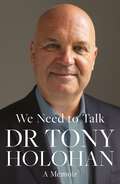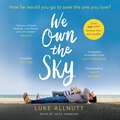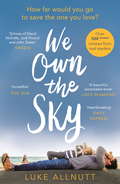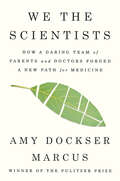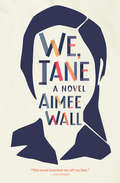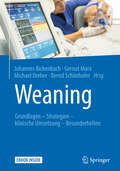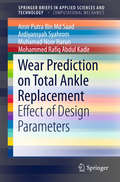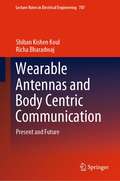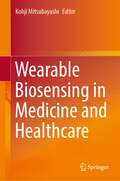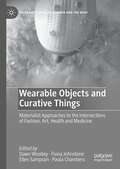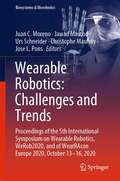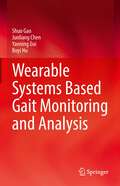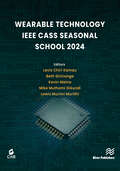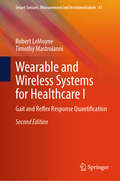- Table View
- List View
We Lived for the Body: Natural Medicine and Public Health in Imperial Germany
by Avi SharmaNature was central to the Wilhelmine German experience. Medical cosmologies and reform-initiatives were a key to consumer practices and lifestyle choices. Nature's appeal transcended class, confession, and political party. Millions of Germans recognized that nature had healing effects and was intimately tied to quality of life. In the 1880s and 1890s, this preoccupation with nature became an increasingly important part of German popular culture. In this pioneering study, Avi Sharma shows that nature, health, and the body became essential ways of talking about real and imagined social and political problems. The practice of popular medicine in the Wilhelmine era brought nature back into urban everyday experience, transforming the everyday lives of ordinary citizens. Sharma explores the history of natural healing in Germany and shows how social and medical practices that now seem foreign to contemporary eyes were, just decades ago, familiar to everyone from small children to their aged grandparents, from tradesmen and women to research scientists. Natural healing was not simply a way to cure illness. It was also seen as a way to build a more healthful society. Using interpretive methods drawn from the history of science and science studies, Sharma provides a readable and groundbreaking inquiry into how popular health and hygiene movements shaped German ideas about progress, modernity, nature, health, and the body at the end of the 19th and the beginning of the 20th century.
We Need to Talk: A Memoir
by Tony HolohanChief Medical Officer Shares His Covid Story Follow Dr. Tony Holohan’s journey as a public figure combating the pandemic during his own period of grief. Leading Ireland through the coronavirus. 12 years as the Chief Medical Officer had never prepared Dr. Holohan for an outbreak like coronavirus pandemic. Thrust into the spotlight as the leader of frontline healthcare workers, he found himself responsible for bringing Ireland through the biggest health crisis in modern history. Now, Dr. Holohan is sharing his story. We Need to Talk is a COVID-19 book retelling the difficult truths that came with navigating a country through a traumatic global crisis. Featuring exclusive access into the decisions that impacted the rise of COVID-19 cases, discover how perseverance and empathy helped Ireland through it all to our post-pandemic world. Taking the time to cherish meaningful experiences.We Need to Talk is a medical memoir dedicated to not only Dr. Tony Holohan’s role during the pandemic, but also the life and loss of his wife, Emer. Sharing her story of battling multiple myeloma for nearly a decade, he recalls their beautiful moments together and with their family before Emer’s last days. With difficult discussions about mourning while moving forward, Dr. Holohan shares the importance of rediscovering those happy memories together after saying goodbye. Also inside: Dr. Holohan’s path to becoming Ireland’s Chief Medical Officer Leading the National Public Health Emergency Team (NPHET) Making the decision to step back to spend time with his loved ones Life after the pandemic and resignation If you liked The People’s Hospital, In Love, or Loving and Living Your Way Through Grief, then you will love We Need to Talk.
We Own The Sky: A heartbreaking page turner that will stay with you forever
by Luke AllnuttA story about love, loss and finding hope-against all odds.Rob Coates can't believe his luck. There is Anna, his incredible wife, and most precious of all, Jack, their son, who makes every day an extraordinary adventure. Rob feels like he's won the lottery of life. Or rather-he did. Until the day it all changes when Anna becomes convinced there is something wrong with Jack.Now Rob sleepwalks through his days, unable to bridge the gulf that separates him from his wife, his son and the business of living. But he's determined to come to terms with what's happened-and find a way back to life, and forgiveness.We Own the Sky will resonate with anyone who has ever suffered loss or experienced great love. Luke Allnutt shows that the journey from hope to despair and back is never as simple as we think, and that even the most thoroughly broken heart can learn to beat again.Read by Jack Hawkins(p) 2018 Orion Publishing Group Ltd
We Own The Sky: An Incredibly Powerful Novel You Won't Be Able to Put Down
by Luke AllnuttHow far would you go to save the one you love?"Anyone who wishes David Nicholls would write faster needs to grab this with both hands." Jill MansellAn emotional page-turner with a heart-pounding dilemma. Fans of Jodi Picoult, David Nicholls and Jojo Moyes will love We Own The Sky.Anna and Rob were the perfect couple with their whole lives in front of them. When beautiful baby boy Jack came along, their world seemed complete.But when tragedy strikes they are faced with an impossible choice. They have one chance to save their child, but at what cost?"...a touching narrative of first love and fatherhood" The Sunday Times****Praise for We Own The Sky'A beautiful, hugely emotional story.' - The Sun'A heartbreaking read about love and loss.' - Bella Magazine'Prepare to have your heart wrenched by this emotion-drenched story.' - Sunday Mirror'This tender depiction of a father's love for his son is utterly heartbreaking and will stay with you long after the book has finished.' - The Express'Deeply affecting. A beautiful, remarkable book.' - Lucy Diamond, author of The Secrets of HappinessUtterly beautiful, heartbreaking and ultimately uplifting. - Rachael Lucas, author of The State of GraceWhat an incredible book this is - such gut-wrenching honesty and depth of emotion. Anyone who wishes David Nicholls would write faster needs to grab this with both hands. It's a truly stunning achievement. - Jill MansellBeautifully rendered and profoundly moving, We Own the Sky illustrates the lengths we'll go to for those we love. Luke Allnutt is a major new talent in fiction and his debut is not to be missed. - Camille Pagán, bestselling author of Life and Other Near-Death Experiences*****What readers are saying about We Own The Sky:'Prepare to weep - I defy anyone to read this and not have a tear in their eye.' reviewer, 5 stars Emotional and moving. - 5* review, AmazonThis is a truly beautiful story told from the heart and written with such great feeling. - 5* review, AmazonI loved this book for its honesty, it's rawness and for its abundance of pure love. It made me laugh, it made me cry, and it will, I know, stay with me for a very long time. - 5* review, Amazon
We Should All Be Birds: A Memoir
by Brian Buckbee Carol Ann FitzgeraldA charming and moving debut memoir about how a man with a mystery illness saves a pigeon, and how the pigeon saves the man. "I loved every page of this book: funny, sad, romantic, and full of pigeons."—Sy Montgomery On a spring evening in Montana, Brian Buckbee encounters an injured baby pigeon. Heartbroken after the loss of the love of his life and increasingly isolated by a mysterious illness that overtook him while trekking through Asia, Brian is unaware that this bird—who he names Two-Step—will change his life. Brian takes in Two-Step, and more injured birds, eventually transforming his home into a madcap bird rehabilitation and rescue center. As Brian and Two-Step grow closer, an unexpected kinship forms. But their paths won’t converge forever: as Two-Step heals and finds love, Brian’s condition worsens, and with his friend’s release back into the world looming closer, Brian must decide where this story leaves him. We Should All Be Birds follows Brian, unable to read or write due to a never-ending headache, as he dictates the end of his old life—as an adventurer, an iconoclastic university instructor, and endurance athlete—through his relationship with a pigeon that comes to define his present. Limited to dictation, Brian teams up with Carol Ann Fitzgerald, an editor who channels the details of his personal history to the pages. Raw and perceptive, delirious and devastating, We Should All Be Birds is an unflinching exploration of chronic illness, grief, connection, and the spectacular beauty of the natural world—and the humble pigeon. The surprising, heartwarming relationship between man and bird provides insight into what it means to love, to suffer, and to "never forget, even for a second, how big it all is."
We Want to Live: The Primal Diet (Expanded and Revised)
by Aajonus VonderplanitzEvery millennium has at least one great catalyst that changes people's lives. This book is one. It reveals how we can live without disease, fear of disease, and the physical, emotional and spiritual bankruptcy that results from disease. Also we learn to live with more clarity, strength and energy. This book includes a remedy section listing hundreds of diseases and aliments, with specific foods and combinations of foods that people have used to cure themselves. Imagine living a life you control, as well as being healthy and feeling great!
We the Scientists: How a Daring Team of Parents and Doctors Forged a New Path for Medicine
by Amy Dockser MarcusA Pulitzer Prize–winning reporter&’s moving narrative of a group of patient advocates who are revolutionizing the way medical research is conducted. For more than half a century, medical advances have been driven by investigators launching experiments inside labs. Science is often conducted in isolation and geared toward the long view. This is the story of a group of people who tried to force the lab doors open: parents whose children had been diagnosed with a rare and fatal genetic condition known as Niemann-Pick disease type C. The disease prevents cells from processing cholesterol, which leads to the progressive loss of the brain&’s and the body&’s ability to function. Recognizing that there would never be a treatment in time to save their children if things stayed the same, the parents set up a collaboration with researchers and doctors in search of a cure.Reconciling different views of science took work. The parents, doctors, and researchers didn't always agree—among themselves or with each other. But together they endeavored to accelerate the development of new drugs. The parents became citizen scientists, identifying promising new treatments and helping devise experiments. They recorded data about the children and co-authored scientific papers sharing findings. They engaged directly with the FDA at each step of the drug approval process. Along the way, they advanced the radical idea that science must belong to us all.Amy Dockser Marcus shows what happens when a community joins forces with doctors and researchers to try to save children&’s lives. Their extraordinary social experiment reveals new pathways for treating disease and conducting research. Science may be forever changed.
We'll Fight It Out Here: A History of the Ongoing Struggle for Health Equity
by David Chanoff Louis W. SullivanHow a coalition of Black health professions schools made health equity a national issue.Racism in the US health care system has been deliberately undermining Black health care professionals and exacerbating health disparities among Black Americans for centuries. These health disparities only became a mainstream issue on the agenda of US health leaders and policy makers because a group of health professions schools at Historically Black Colleges and Universities banded together to fight for health equity. We'll Fight It Out Here tells the story of how the Association of Minority Health Professions Schools (AMHPS) was founded by this coalition and the hard-won influence it built in American politics and health care. David Chanoff and Louis W. Sullivan, former secretary of health & human services, detail how the struggle for equity has been fought in the field of health care, where bias and disparities continue to be volatile national issues. Chanoff and Sullivan outline the history of Black health care, from pre-Emancipation to today, centering on the work of AMHPS, which brought to light health care inequities in 1983 and precipitated virtually all minority health care legislation since then. Based on extensive research in the literature, as well as more than seventy interviews with the people central to this fight for legislative and policy change, We'll Fight It Out Here is the important story of a vital coalition movement, virtually unknown until now, that changed the national understanding of health inequities.The work of this coalition of Black health schools continues, both in supporting the training of more doctors and health professionals from minority backgrounds and in advancing issues related to health equity. By highlighting these endeavors, We'll Fight It Out Here brings attention to a pivotal group in the history of the health equity movement and provides a road map of practical mechanisms that can be used to advance it.
We've Got You Covered: Rebooting American Health Care
by Amy Finkelstein Liran EinavFrom a MacArthur Genius MIT economist and pre-eminent Stanford economist comes a lively and provocative proposal for American health insurance reformFew of us need convincing that the American health insurance system needs reform. But many of the existing proposals focus on expanding one relatively successful piece of the system or building in piecemeal additions. These proposals miss the point.As the Stanford health economist Liran Einav and the MIT economist and MacArthur Genius Amy Finkelstein argue, our health care system was never deliberately designed, but rather pieced together to deal with issues as they became politically relevant. The result is a sprawling yet arbitrary and inadequate mess. It has left 30 million Americans without formal insurance. Many of the rest live in constant danger of losing their coverage if they lose their job, give birth, get older, get healthier, get richer, or move.It's time to tear it all down and rebuild, sensibly and deliberately. Marshaling original research, striking insights from American history, and comparative analysis of what works and what doesn&’t from systems around the world, Einav and Finkelstein argue for automatic, basic, and free universal coverage for everyone, along with the option to buy additional, supplemental coverage. Their wholly original argument and comprehensive blueprint for an American universal health insurance system will surprise and provoke.We&’ve Got You Covered is an erudite yet lively and accessible prescription we cannot afford to ignore.
We, Jane
by Aimee WallA remarkable debut about intergenerational female relationships and resistance found in the unlikeliest of places, We, Jane explores the precarity of rural existence and the essential nature of abortion.??Searching for meaning in her Montreal life, Marthe begins an intense friendship with an older woman, also from Newfoundland, who tells her a story about purpose, about a duty to fulfill. It's back home, and it goes by the name of Jane.??Marthe travels back to a small community on the island with the older woman to continue the work of an underground movement in 60s Chicago: abortion services performed by women, always referred to as Jane. She commits to learning how to continue this legacy and protect such essential knowledge. But the nobility of her task and the reality of small-town life compete, and personal fractures within their group begin to grow.??We, Jane probes the importance of care work by women for women, underscores the complexity of relationships in close circles, and beautifully captures the inevitable heartache of understanding home.Praise for We, Jane:"An incendiary novel about love between women, reproductive rights, rural Newfoundland and a brave, absolutely fierce feminism in a world 'simmering with heat and rage.' It's about coming home, about risk, and passing the torch. Beautifully crafted, alive with vision, propulsive and intimate, this novel knocked me off my feet. We, Jane is striking, indelible." —Lisa Moore, author of Something for Everyone
Wealth, Health, and Democracy in East Asia and Latin America
by James W. McguireWhy do some societies fare well, and others poorly, at reducing the risk of early death? Wealth, Health, and Democracy in East Asia and Latin America finds that the public provision of basic health care and other inexpensive social services has reduced mortality rapidly even in tough economic circumstances, and that political democracy has contributed to the provision and utilization of such social services, in a wider range of ways than is sometimes recognized. These conclusions are based on case studies of Argentina, Brazil, Chile, Costa Rica, Indonesia, South Korea, Taiwan, and Thailand, as well as on cross-national comparisons involving these cases and others.
Weaning from Mechanical Ventilation: A State-of-the-Art Approach
by Antuani Rafael Baptistella Daniel Lago Borges Luis Felipe da Fonseca ReisThis book provides a broad, detailed, and up-to-date approach to weaning from mechanical ventilation, offering readers insights into basic physiology, ventilation modes, and the spontaneous breathing test. It also delves into modern tools such as ultrasound, inspiratory muscle training, and AI applications in weaning. Additionally, it covers non-invasive mechanical ventilation, sedation, and weaning in special populations, including patients with COPD, cardiopathy, neurological conditions, and those affected by COVID-19. Key concepts explored include the physiological underpinnings of weaning, the latest advancements in ventilation technology, and the integration of physiotherapy techniques. The book addresses critical questions such as how to optimize weaning protocols and improve patient outcomes. Contributions from experienced practitioners and scholars provide a thorough analysis of current practices and emerging trends, making this book a must-read for those seeking to enhance their understanding and skills in critical care. Weaning from Mechanical Ventilation – A State-of-the-Art Approach is an indispensable resource for physicians, physiotherapists, respiratory therapists, nurses, and anyone involved in the management of patients requiring mechanical ventilation. It is designed to equip healthcare professionals with the knowledge needed to improve patient outcomes and enhance critical care practice.
Weaning: Grundlagen - Strategien - Klinische Umsetzung - Besonderheiten
by Gernot Marx Johannes Bickenbach Michael Dreher Bernd SchönhoferIn diesem Werk beschreibt ein interdisziplinäres Herausgeber- und Autorenteam die Grundlagen, Strategien und Besonderheiten der Beatmungsentwöhnung („Weaning“). Das Buch wendet sich an alle Berufsgruppen, die Patienten im Weaningprozess betreuen, wie Intensivmediziner, Pneumologen, Pflegekräfte, Physiotherapeuten und Atmungstherapeuten. Dargestellt werden Ursachen, Pathophysiologie und Therapie des Weaningversagens, ebenso wie die Besonderheiten der Beatmungsentwöhnung bei Multimorbidität und bei Infektionen mit multiresistenten Erregern. Informationen zum Aufbau und Ausbau von Weaningstationen sowie zu Qualitätsmanagement und Zertifizierungskonzepten liefern wertvolles „Know-How“ für die Implementierung oder Weiterentwicklung einer Weaningstation. Auch ethische Aspekte am Lebensende von beatmeten Patienten werden ausführlich behandelt - ebenso wie telemedizinische Aspekte beim Weaning, die außerklinische Beatmung, neue Beatmungsverfahren sowie neue Verfahren der Bildgebung. Vor allem die Ausführungen zu wichtigen Weaningstrategien nehmen Bezug auf die S2k-Leitlinie zum prolongierten Weaning. Ein praxisnahes Werk mit zahlreichen Tipps und Fallbeispielen.
Wear Prediction on Total Ankle Replacement
by Muhamad Noor Harun Ardiyansyah Syahrom Mohammed Rafiq Abdul Kadir Amir Putra Bin Md SaadThis book develops and analyses computational wear simulations of the total ankle replacement for the stance phase of gait cycle. The emphasis is put on the relevant design parameters. The book presents a model consisting of three components; tibial, bearing and talar representing their physiological functions.
Wearable Antennas and Body Centric Communication: Present and Future (Lecture Notes in Electrical Engineering #787)
by Shiban Kishen Koul Richa BharadwajThis book presents state-of-the-art technologies, trends and applications with a focus on the healthcare domain for ultra-wideband (3.1–10.6 GHz) and 60 GHz (57–66 GHz) wireless communication systems. Due to various key features such as miniaturized antenna design, low power, high data rate, less effects on the human body, relatively less crowded spectrum, these technologies are becoming popular in various fields of biomedical applications and day-to-day life. The book highlights various aspects of these technologies related to body-centric communication, including antenna design requirements, channel modeling and characterization for WBANs, current fabrication and antenna design strategies for textile, flexible and implanted antennas. Apart from the general requirements and study related to these frequency bands, various application specific topics such as localization and tracking, physical activity recognition and assessment, vital sign monitoring and medical imaging are covered in detail. The book concludes with the glimpses of future aspects of the UWB and 60 GHz technology which includes IoT for healthcare and smart living, novel antenna materials and application of machine learning algorithms for overall performance enhancement.
Wearable Biosensing in Medicine and Healthcare
by Kohji MitsubayashiThis book contains chapters on wearable biomedical sensors and their assistive technologies for promoting behavioral change in medical and health care. Part I reviews several wearable biomedical sensors based on biocompatible materials and nano and micro-electromechanical systems (MEMS) technologies in the medical and dental fields. Part II introduces the latest approaches to wearable biosensing using unique devices for various skin targets such as sweat, interstitial fluid, and transcutaneous gases. Part III presents technologies supporting wearable sensors, including soft and flexible materials, manufacturing methods, skin volatile-marker imaging, and energy harvesting devices.This book is intended for graduate students, academic researchers, and professors that work in medical and healthcare research fields, as well as industry professionals involved in the development of wearable and flexible sensing devices and measurement systems for human bio/chemical sensing, medical monitoring, and healthcare services, and for medical professionals and government officials who are driving behavior change in health care.
Wearable Objects and Curative Things: Materialist Approaches to the Intersections of Fashion, Art, Health and Medicine (Palgrave Studies in Fashion and the Body)
by Fiona Johnstone Ellen Sampson Paula Chambers Dawn WoolleyThis book explores the intersections between wearable objects and human health, with particular emphasis on how artists and designers are creatively responding to and rethinking these relations. Addressing a rich range of wearable artefacts, from mobility aids and prosthetics to clothing and accessories to digital health tracking devices, its themes include care and cure; wellness culture and the commoditization of health; and the complex interactions between (human) bodies and (non-human) objects. With a theoretical framework inspired by the work of materialist thinkers including Sherry Turkle, Bruno Latour and Jane Bennett, and bringing the disciplinary fields of fashion studies, art and design practice, and medical and health humanities into dialogue for the first time, this volume draws attention to the complex agencies entangled in the things we wear, and situates fashion and art in relation to broader cultural and historical contexts of health, illness and disability.
Wearable Robotics: Proceedings of the 4th International Symposium on Wearable Robotics, WeRob2018, October 16-20, 2018, Pisa, Italy (Biosystems & Biorobotics #22)
by José L. Pons Maria Chiara Carrozza Silvestro MiceraThe book reports on advanced topics in the areas of wearable robotics research and practice. It focuses on new technologies, including neural interfaces, soft wearable robots, sensors and actuators technologies, and discusses important regulatory challenges, as well as clinical and ethical issues. Based on the 4th International Symposium on Wearable Robotics, WeRob2018, held October 16-20, 2018, in Pisa, Italy, the book addresses a large audience of academics and professionals working in government, industry, and medical centers, and end-users alike. It provides them with specialized information and with a source of inspiration for new ideas and collaborations. It discusses exemplary case studies highlighting practical challenges related to the implementation of wearable robots in a number of fields. One of the focus is on clinical applications, which was encouraged by the colocation of WeRob2018 with the International Conference on Neurorehabilitation, INCR2018. Additional topics include space applications and assistive technologies in the industry. The book merges together the engineering, medical, ethical and political perspectives, thus offering a multidisciplinary, timely snapshot of the field of wearable technologies.
Wearable Robotics: Proceedings of the 5th International Symposium on Wearable Robotics, WeRob2020, and of WearRAcon Europe 2020, October 13–16, 2020 (Biosystems & Biorobotics #27)
by Juan C. Moreno Jawad Masood Urs Schneider Christophe Maufroy Jose L. PonsThis book reports on advanced topics in the areas of wearable robotics research and practice. It focuses on new technologies, including neural interfaces, soft wearable robots, sensors and actuators technologies, discussing industrially and medically-relevant issues, as well as legal and ethical aspects. It covers exemplary case studies highlighting challenges related to the implementation of wearable robots for different purposes, and describing advanced solutions. Based on the 5th International Symposium on Wearable Robotics, WeRob2020, and on WearRacon Europe 2020, which were both held online on October 13-16, 2020, the book addresses a large audience of academics and professionals working in for the government, in the industry, and in medical centers, as well as end-users alike. By merging together engineering, medical, ethical and industrial perspectives, it offers a multidisciplinary, timely snapshot of the field of wearable technologies.
Wearable Systems Based Gait Monitoring and Analysis
by Shuo Gao Junliang Chen Yanning Dai Boyi HuWearable Systems Based Gait Monitoring and Analysis provides a thorough overview of wearable gait monitoring techniques and their use in health analysis. The text starts with an examination of the relationship between the human body’s physical condition and gait, and then introduces and explains nine mainstream sensing mechanisms, including piezoresistive, resistive, capacitive, piezoelectric, inductive, optical, air pressure, EMG and IMU-based architectures. Gait sensor design considerations in terms of geometry and deployment are also introduced. Diverse processing algorithms for manipulating sensors outputs to transform raw data to understandable gait features are discussed. Furthermore, gait analysis-based health monitoring demonstrations are given at the end of this book, including both medical and occupational applications. The book will enable students of biomedical engineering, electrical engineering, signal processing, and ergonomics and practitioners to understand the medical and occupational applications of engineering-based gait analysis and falling injury prevention methods.
Wearable Technology: IEEE CASS Seasonal School 2024
by Levis Chiri Kamau Beth Gichanga Kevin Maina Mike Muthomi Gikundi Lewis Murimi MurithiThis book is the result of a groundbreaking milestone CASS seasonal school dedicated to Wearable Technology that was held for the first time in Africa. It is a reference on the evolving terrain of wearable tech and circuit-based technologies in specific fields including data processing and signal analysis, enhancing patient monitoring, and improving quality of life for senior adults. It also covers broad topics such as trends in wearable technology and the art of circuit design.The seasonal school provided exclusive opportunities for attendees to interact with renowned experts across multiple domains. Participants gained invaluable insights into the forefront of innovation, equipping them with the knowledge and skills necessary to thrive in this rapidly evolving field. The school brought forward real-world examples as well as the latest global advancements in wearable technology. Facilitating direct engagement with leading experts in the field and fostering networking opportunities, the school served as a center for knowledge exchange and professional growth.
Wearable and Wireless Systems for Healthcare I: Gait and Reflex Response Quantification (Smart Sensors, Measurement and Instrumentation #47)
by Timothy Mastroianni Robert LeMoyneThis book is the second edition of the one originally published in 2017. The original publication features the discovery of numerous novel applications for the use of smartphones and portable media devices for the quantification of gait, reflex response, and an assortment of other concepts that constitute first-in-the-world applications for these devices. Since the first edition, numerous evolutions involving the domain of wearable and wireless systems for healthcare have transpired warranting the publication of the second edition. This volume covers wearable and wireless systems for healthcare that are far more oriented to the unique requirements of the biomedical domain. The paradigm-shifting new wearables have been successfully applied to gait analysis, homebound therapy, and quantifiable exercise. Additionally, the confluence of wearable and wireless systems for healthcare with deep learning and neuromorphic applications for classification is addressed. The authors expect that these significant developments make this book valuable for all readers.
Wearable and Wireless Systems for Healthcare II: Movement Disorder Evaluation and Deep Brain Stimulation Systems (Smart Sensors, Measurement and Instrumentation #49)
by Timothy Mastroianni Robert LeMoyne Donald Whiting Nestor TomyczThis book is the second edition of the one originally published in 2019. The original publication features the discovery of numerous novel applications for the use of smartphones and portable media devices for the quantification of deep brain stimulation for the treatment of movement disorders that constitute first-in-the-world applications for these devices. Since the first edition, numerous evolutions involving the domain of wearable and wireless systems for healthcare and deep brain stimulation have transpired warranting the publication of the second edition. This volume covers wearable and wireless systems for healthcare that are far more relevant to the unique requirements of the domain of deep brain stimulation. The paradigm-shifting new wearables comprising attributes of conformability and further miniaturization have been recently applied for the context of deep brain stimulation. Additionally, the subjects of automated optimization for deep brain stimulation and the rampantly expanding additional applications for deep brain stimulation are addressed. The authors expect that these significant developments make this book valuable for all readers.
Wearable/Personal Monitoring Devices Present to Future
by Ganesh R. Naik Gaetano D. GargiuloThis book discusses recent advances in wearable technologies and personal monitoring devices, covering topics such as skin contact-based wearables (electrodes), non-contact wearables, the Internet of things (IoT), and signal processing for wearable devices. Although it chiefly focuses on wearable devices and provides comprehensive descriptions of all the core principles of personal monitoring devices, the book also features a section on devices that are embedded in smart appliances/furniture, e.g. chairs, which, despite their limitations, have taken the concept of unobtrusiveness to the next level. Wearable and personal devices are the key to precision medicine, and the medical community is finally exploring the opportunities offered by long-term monitoring of physiological parameters that are collected during day-to-day life without the bias imposed by the clinical environment. Such data offers a prime view of individuals’ physical condition, as well as the efficacy of therapy and occurrence of events. Offering an in-depth analysis of the latest advances in smart and pervasive wearable devices, particularly those that are unobtrusive and invisible, and addressing topics not covered elsewhere, the book will appeal to medical practitioners and engineers alike.

